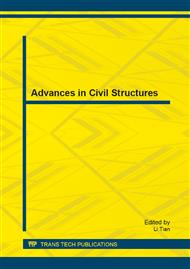p.1616
p.1620
p.1625
p.1629
p.1637
p.1641
p.1648
p.1652
p.1657
Experimental Research on Residual Strength of Concrete under Fatigue Loading and Corrosion of Magnesium Nitrate
Abstract:
At Present, stress corrosion and corrosion fatigue causing durability degradation of concrete structure in the field of civil engineering become an important problem,and thus become a hot topic to study. But the research on it at home and abroad is still in stage of theoretical exploration. This paper using self-designed corrosion fatigue loading test device, studied in magnesium nitrate solution of concrete under the action of erosion strength increasing regularity, results show that the concrete strength by corrosion fatigue than fatigue specimen attenuation extent.
Info:
Periodical:
Pages:
1637-1640
Citation:
Online since:
August 2013
Authors:
Price:
Сopyright:
© 2013 Trans Tech Publications Ltd. All Rights Reserved
Share:
Citation:


